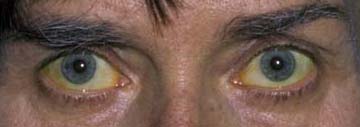Bilirubin
Clinical relevance
Conjugated bilirubin is soluble in water and is partially eliminated in urine. When the concentration of conjugated bilirubin increases in the blood, urine bilirubin becomes measurable, i.e. in cases of icterus jaundice (jaundice), biliary tract obstruction of the bile or hepato-cellular damage.

Test strip, from left to right: comparison scale, then a negative result, then a positive result corresponding to +++ blirubinuria.
Intra or extravascular hemolysis induces an increase of non-conjugated bilirubin, which is not water soluble, hence cannot be eliminated in urine.
 |
An easy diagnosis of icterus (jaundice) can be made by observing the sclera and the skin. A yellow coloration of the sclera is visible when the plasma concentration of bilirubin is above 35 μmol/L (2mg/dL). Urine is yellow to dark brown. The presence of a brown colored foam is typical (“urine beer”, on the left).
Combining the results of bilirubin and urobilirubin test strips can provide a preliminary differential diagnosis of icterus:
| healthy | hemolysis | hepato-cellular affection | biliary tract occlusion | |
|---|---|---|---|---|
| Urobilinogen | normal | increased | increased | absent or decreased |
| Bilirubin | négatif | negative | positive or negative | positive |
Note:biliary pigments in urine have less clinical importance since hepatic enzymes and serology testing is available.